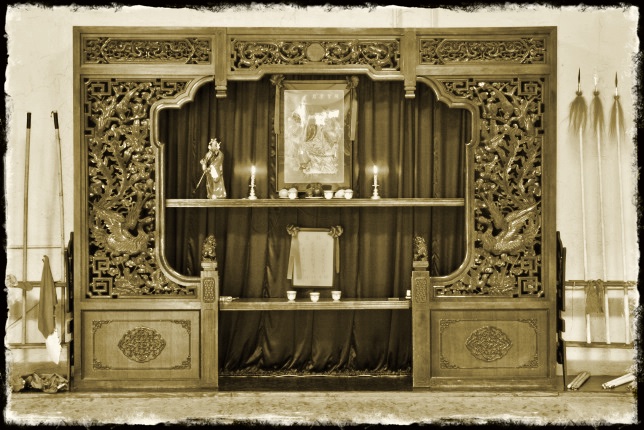
About Shaolin Hung Mei Kung Fu
Culture Of SHMKF
Respecting Our Ancestors and Lineage
As is common in schools of truly traditional martial practices, a Shrine is placed in the front of the class and represents
 one of the most important means of showing respect for the system’s ancestors and lineage. The Shrine is a critical component
of the cultural heritage of Shaolin Hung Méi Kung Fu (少林洪眉派功夫) and not only gives us the opportunity to show respect to
Guān Yŭ (關羽) (also called Yún Cháng (雲長) or Guān Gōng (關公)), one of the greatest men in China’s over 5,000 year history,
but to honor our Hung Mèi and Hung Mén ancestors (see History of Shaolin Hung Mei Kung Fu).
one of the most important means of showing respect for the system’s ancestors and lineage. The Shrine is a critical component
of the cultural heritage of Shaolin Hung Méi Kung Fu (少林洪眉派功夫) and not only gives us the opportunity to show respect to
Guān Yŭ (關羽) (also called Yún Cháng (雲長) or Guān Gōng (關公)), one of the greatest men in China’s over 5,000 year history,
but to honor our Hung Mèi and Hung Mén ancestors (see History of Shaolin Hung Mei Kung Fu).
The Shrine is divided into two parts, an upper half and a lower half. The picture in the top half shows Guān Yŭ (關羽) and his two sworn blood brothers, Liú Bèi (劉備) and Zhāng Fēi (張飛). Guān Yŭ (關羽) is the man with the red face and the long, flowing beard. In China, whereas Confucius is worshipped as the greatest man of scholarly learning, Guān Yŭ (關羽) is worshipped as the greatest man of military prowess. His influence on the morality and practices of the Chinese has been far-reaching.
Guān Yŭ (關羽) was born in Xièxian (present day Changpíng Village, Xiézhōu Town, Yúnchéng, Shān Xī (山西) Province) in A.D. 160. He was an excellent master of martial arts and was known for his strength, dedication, honesty, loyalty and patriotism. As a result, many emperors granted him honorary titles, the most popular of which, "Guān the Holy King," was given to him by Emperor Wan Lì of the Ming dynasty.
It is said that Guān Yŭ (關羽) was first worshipped as a divine being sometime during the Suí (隋) Dynasty (A.D. 581-618). One night, a Buddhist Monk, Zhi Kai, claimed to have seen a vision of Guān Yŭ who wanted to become a disciple of Buddha. Afterward, Zhi Kai reported the meeting to Yang Guang, Prince of Jin, who gave Guān Yŭ (關羽) the title of "Temple Guardian of Law".
To properly show respect for Guān Yŭ (關羽), Liú Bèi (劉備) and Zhāng Fēi (張飛), three cups of tea and three plates with three pieces of fruit on each, are placed on the top shelf of the Shrine at the beginning of each class. In addition, the Teacher or a senior student lights three sticks of incense and, holding the incense, bows to the Shrine three times.
The plaque mounted on the bottom half of the Shrine pays respect to our Hung family ancestors. The writing across the top and down the center of the plaque essentially translates as "…in honor of the Shaolin ancestors who are seated here…". The names found to the left of center, Léi Bāi Xíng (雷白行) and Wú Shén Xĭ (吳神禧), are our forefathers from Hung Méi. The names to the right, Lín Ya Qìng (林亞慶) and Huáng Shuĭ Xíng (黃水行), are our ancestors from Hung Mén (see History of Shaolin Hung Mei Kung Fu). In Chinese culture, only the names of the Grandmasters who have passed away can be placed on the plaque. We light one stick of incense in remembrance of all of those who came before us.
Generations (輩份)
With the beginnings of Kung Fu (功夫) in ancient China, the tradition of generations was established. A generation begins with the formation of a group of disciples in training under a Shī Fù (師父). When one of these disciples, in turn, becomes a Shī Fù (師父) with his or her own group of students, a new generation is born. Each succeeding generation is started in this way and will continue as long as there are teachers and students (see Senior Teachers).
In Kung Fu (功夫), as in any culture or society, there are different ways of showing respect. In Kung Fu, this greeting or show of respect is called "bai" (拜) or "bai zhù" (拜祝). As will be shown in class, there are different ways to perform the "bai" (拜) depending upon whether the student is showing respect to Tai Shī Fù (太師父), Shī Fù (師父) or Shī Xiōng (師兄) (Elder Brother/senior male student), Shī Jiě (師姐) (Elder Sister/senior female student), Shī Dì (師弟) (Younger brother/junior male student) or Shī Méi (師妹) (Younger Sister/junior female student). The stance for the "bai" (拜) shown to Shī Fù (師父) is called Diē Bó (跌搏), where one knee is down. As the generations alternate, so does the knee which is placed on the ground. For example, the students who learned directly from Zōng Shī Wú Shén Xī (宗師吳神禧), "bai" with the left knee down. Those who learn from his student, Tai Shī Fù Tonny Kho (師父許敬唐), will "bai" with their right knee down.
Another way in which the generation of a particular disciple is displayed is the side on which he or she knots the sash. Each succeeding generation alternates the side on which the sash is tied.
"…Your group’s performances are an excellent way to foster understanding of Asian, particularly Chinese, culture and traditions… Your commitment to rituals and traditions helps to pass on culture and traditions to the younger generation".
Sue Bramley - Marketing Events Manager, International Channel
(see Testimonials)
